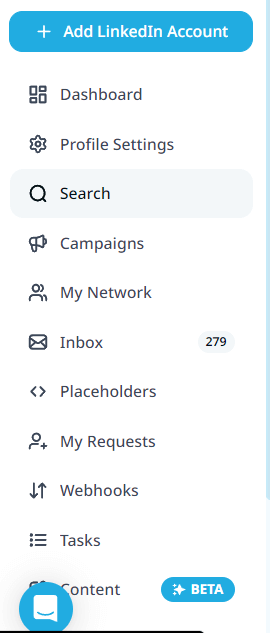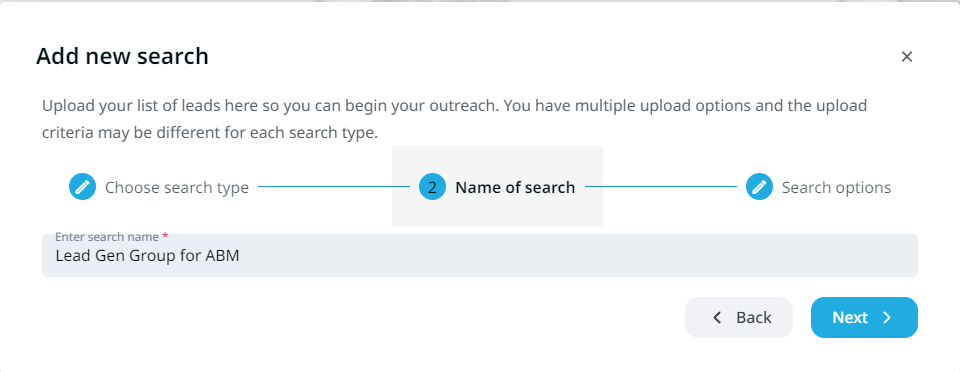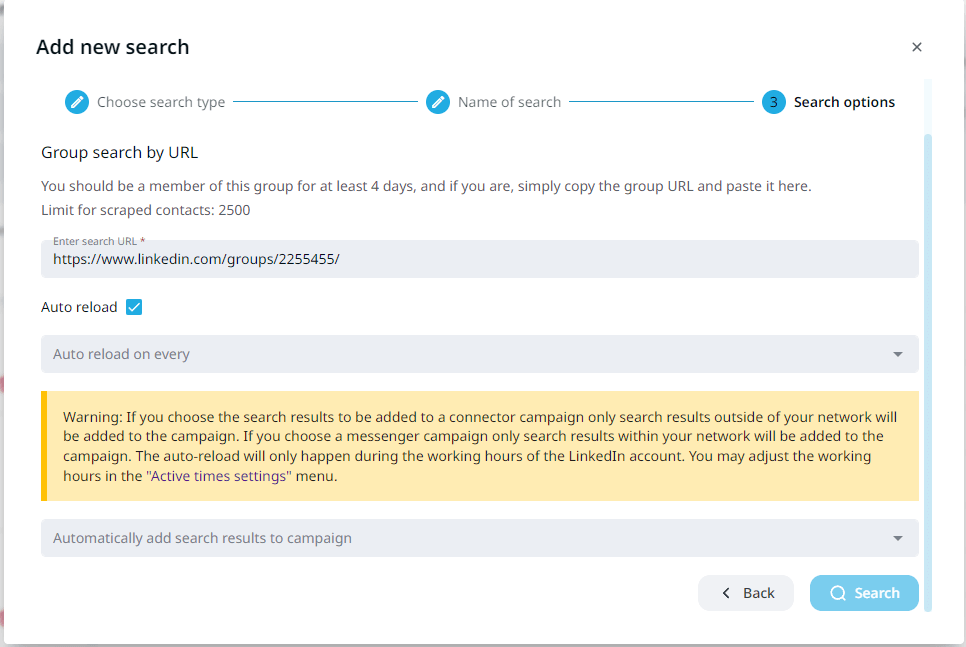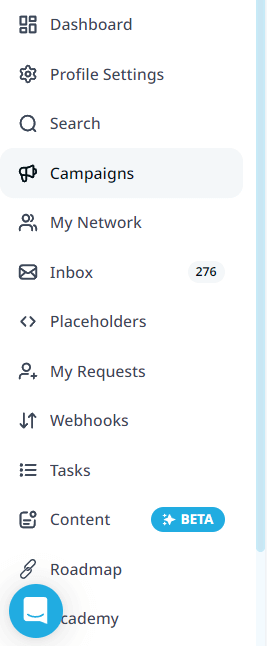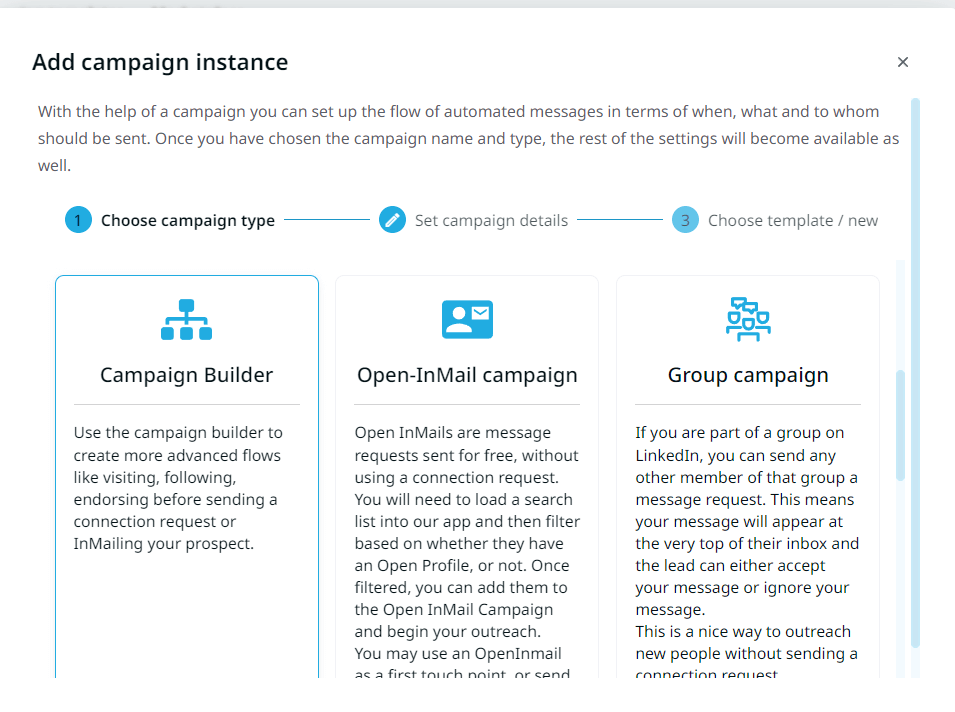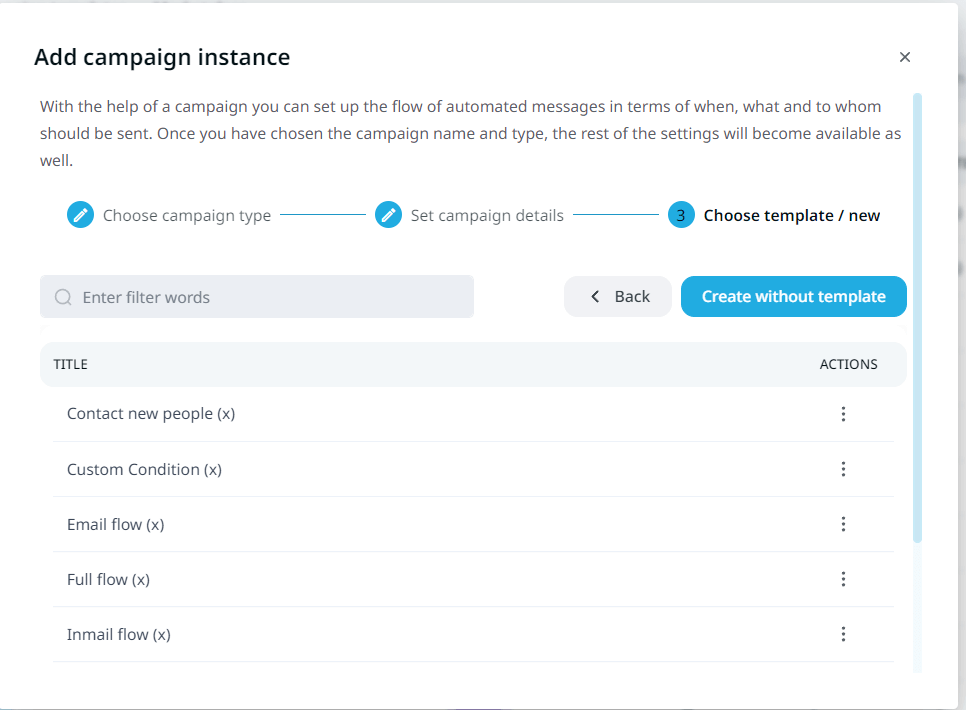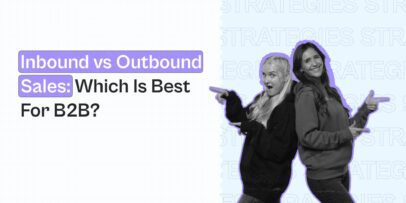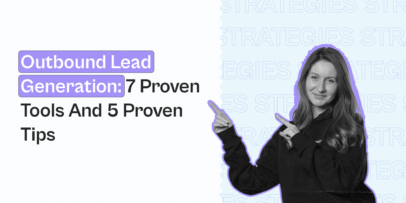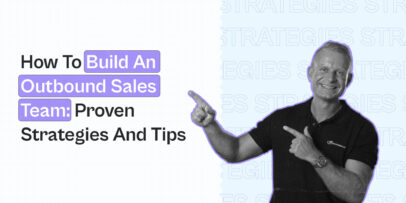Ultimate LinkedIn Account-Based Marketing Guide
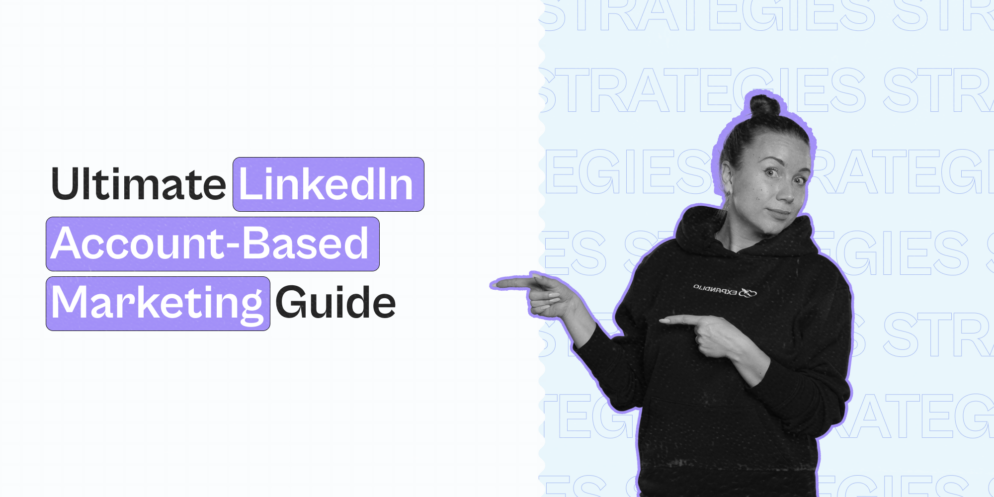
Account-based marketing is the perfect mix of marketing and sales to generate leads on autopilot.
To succeed in today’s marketing and lead generation era, you need to be where your audience is.
For most B2B businesses, this means an omnichannel approach of LinkedIn and email.
That’s because LinkedIn is responsible for 97% of a business’s social media leads.
But there’s one important thing to keep in mind when doing lead generation on the platform.
The rules of the game are changing.
Before, you could set up an automated outreach campaign and generate leads on autopilot.
Nowadays, things are different.
LinkedIn is growing at breakneck speed and you need to adapt your approach if you want to stand out.
This is where account-based marketing comes in.
But first, is ABM right for you?
It might be IF you:
- Have a bigger marketing and outreach budget.
- Want to target bigger companies and multiple leads in one department to get on their radar.
- Have your sales and marketing teams aligned working on the same page.
- Want to build deeper relationships and drive long-term value.
However, ABM is probably NOT for you, if you:
- Have a limited budget to invest in the proper tools and employees.
- Target a broad audience, as ABM is designed to focus on a select group of high-value accounts.
- Have shorter sales cycle or low-value transactions. ABM is most effective for businesses selling a more complex solution to other, larger businesses while focusing on multiple sales channels.
ABM is not just “personalized outreach but better”.
It takes more effort, time, and a bigger budget. Additionally, it’ll only work if you have a well-defined, high-value accounts to sell to.
And if you don’t have those, then this article might not be for you.
Now, if you’re ready to invest in ABM in order to generate leads, nurture prospects, and grow relationships automatically over time, you’ll want to keep on reading.
Here’s what we’ll cover below:
- What is LinkedIn account-based marketing and how does it work?
- Understanding the essentials of ABM and why you should be using LinkedIn if you work in B2B
- 2 Main tools you need to be using to launch and automate your first ABM campaign
- Detailed breakdown on how to use LinkedIn Sales Navigator with ABM
- Detailed breakdown on how to use Expandi to fully automate your ABM campaigns
- 3 Best practices you should always keep in mind when managing ABM
PS – Before we begin, we have a private community group called The LinkedIn Outreach Family. If you want to learn the ins and outs of LinkedIn marketing for free, be sure to join the group and say hi!
What Is LinkedIn Account-Based Marketing (ABM)?
At its core, LinkedIn account-based marketing (ABM) is a marketing strategy that focuses on building relationships and engaging specific key prospects.
ABM recognizes that not all leads are equal and that targeting high-value accounts will yield better results.
So, instead of casting a wide net and hoping for conversions, ABM enables you to identify and focus on the most promising prospects first. Which, in turn, increases your chances of generating quality leads and driving revenue growth.
This is ideal for LinkedIn in particular because:
- The platform is constantly growing, with over 930 million users and counting.
- The algorithm is cracking down on spammers and low-quality outreach.
- As more people check their focused inbox, you’re more likely to get noticed with your follow-ups.
- It’s easier than ever to find your audience on the platform with tools like Sales Navigator.
- You can follow up with your leads via LinkedIn InMail and regular email.
If you’re not sure what this will look like in practice, be sure to read on. We’ll cover in detail how to automate your first account-based marketing using Expandi and LinkedIn Sales Navigator.
But first, let’s uncover how ABM works in detail.
Understanding How Account-Based Marketing Works In practice
So, how does ABM actually work?
At its core, ABM is all about targeting and serving high-value clients.
If you’re selling a low ticket offer (e.g. at $1,000/mo), ABM will not be worth the effort for you.
And doing simple, personalized outreach will be better.
However, if you’re selling to companies who can afford to pay you a lot (e.g. $100,000/year), generating those kinds of leads or closing them over a simple LinkedIn message will be much more difficult.
This is where ABM comes in.
ABM covers different channels from different perspectives and targets multiple people from inside the company.
For example, if you’re a digital agency that works exclusively with other big brands, instead of just sending a personalized connection request and following up on email, in an ABM outreach, you’d also be:
- Creating personalized articles specifically to attract them.
- Creating content based on your case studies and proven processes.
- Running ads for specific people within the company.
- Reaching out via LinkedIn and email.
- And more.
Looking at the bigger picture, ABM has become the go-to strategy for many brands because of:
- Rising cost of customer acquisition (CAC) – The cost of acquiring new customers has increased significantly. ABM allows businesses to focus their resources on high-value accounts that drive more revenue – improving overall ROI and reducing CAC.
- Relationship building – Building relationships with your prospects is essential for sales success. ABM recognizes the importance of this and allows you to deliver personalized experiences with key decision-makers at scale. Over time, this leads to sales and customer loyalty.
- Enhanced personalization at scale – For your account-based marketing to feel natural and authentic, prospects expect personalized experiences. ABM leverages data and insights to create highly personalized campaigns based on the specific individual. By tailoring content and outreach messaging to specific people, you cut through the noise and deliver relevant value propositions. We’ll cover how to automatically create personalized messaging for your ABM campaigns below.
With all this in mind, LinkedIn is the obvious choice for account-based marketing.
Here’s why.
3 Main reasons why use LinkedIn for ABM over any other platform
As mentioned above, there are over 930 million users on LinkedIn and it’s the go-to platform for lead generation for anyone working in the B2B sphere.
There are several reasons why B2B marketers should be taking advantage of LinkedIn when it comes to ABM.
Firstly, you can find your target audience on the platform, no matter your niche, industry, or profession.
With the platform’s default search filters and advanced X-ray search options, you can reach specific industries, job titles, professional backgrounds, companies, and more.
Simply put, if you work in B2B, you can find your audience on LinkedIn.
See our guide on defining your ideal customer profile vs buyer persona if you need more help finding your target audience on LinkedIn.

This leads us to the second point: Relationship building.
Building strong relationships with your prospects is crucial for success nowadays. That’s because people are already used to receiving many different pitches daily.
If you want to stand out, you should focus on offering value and establishing connections.
Account-based marketing recognizes this and focuses on establishing trust and rapport with prospects. By delivering personalized experiences and engaging key decision-makers, you’re more likely to foster long-term relationships that can lead to sales and customer loyalty.
Finally, the third reason you should be using LinkedIn for ABM has to do with enhanced personalization.
Essentially, ABM leverages data and prospect insights to create highly targeted and personalized campaigns.
By tailoring content and messaging to the specific individual, you can cut through the noise and deliver relevant value propositions to the right people.
Is ABM right for you? Quick checklist overview
So, to recap so far, here’s a quick list of questions you can use to determine if ABM is for you.
Do you:
- Have a bigger marketing and outreach budget for multiple tools?
- Sell a high-value solution to bigger brands?
- Target specific decision-makers in a big business instead of a broad audience?
- Have a longer sales cycle that requires multiple touch points?
- Have the time to put in the extra effort and resources for ABM?
- Have an aligned sales and marketing teams?
- Understand the core principles of ABM, including how to do personalization, account-centric approach, and align sales and marketing at scale?
If so, good, we can continue.
If not though, you might want to look into our general growth hacks to generate leads on LinkedIn instead.
Now, let’s take a practical look at how to get started with account-based marketing on LinkedIn.
5 Main LinkedIn Tools You Need To Launch Your First ABM Campaign
Looking at the bigger picture, to launch your first ABM campaign you need to:
- Define and find your target audience on LinkedIn.
- Automatically scrape the audience.
- Automatically reach out to them in a lead nurturing sequence campaign.
- Personalize your outreach messages.
- Follow-up via email to get their attention.
LinkedIn Sales Navigator for account-based marketing
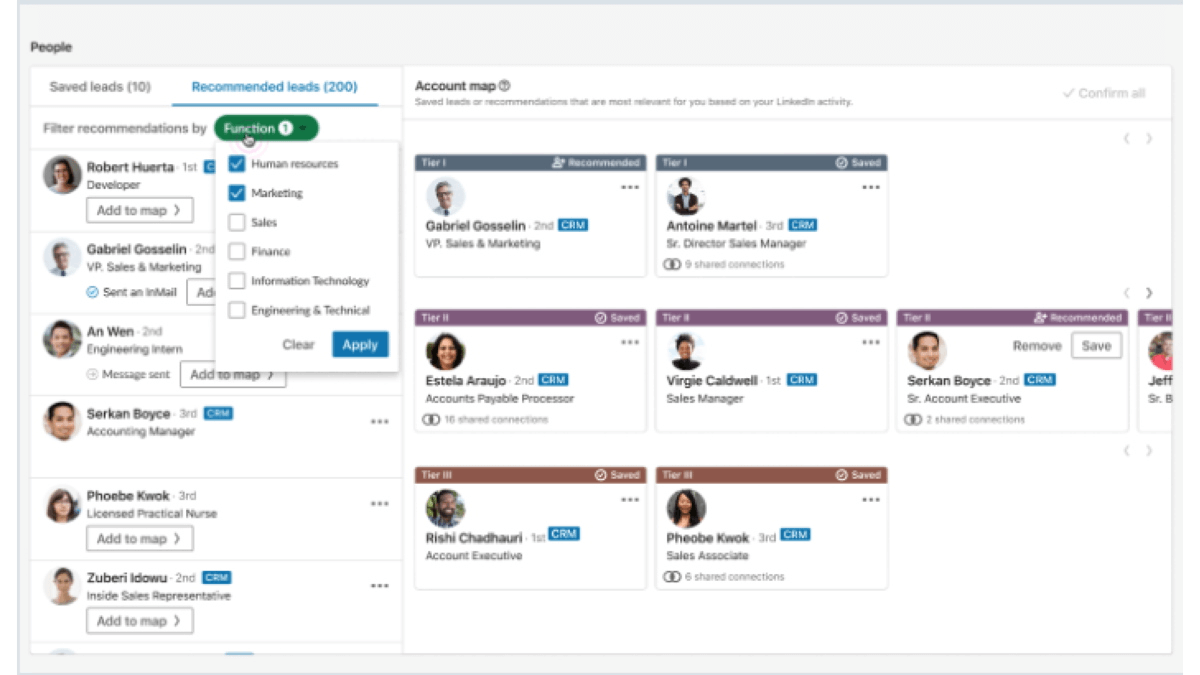
LinkedIn Sales Navigator is the premium version of LinkedIn that helps you find leads much more efficiently.
While you can get away with using the free, default version of LinkedIn, it’s recommended you pay extra for that sniper-targeting Sales Navigator offers. Especially if you’re looking for a very specific target audience.
With Sales Navigator, you can find leads with advanced search options, such as:
- Job change alerts.
- Advanced LinkedIn group filters.
- Finding similar profiles as your ideal prospects.
- “Posted on LinkedIn” search filter.
- Department headcount.
- Number of followers.
- Years of experience.
- And more.
All of this is ideal for account-based marketing because you can set up really specific search filters for your target audience.
Additionally, these filters make it really easy to target multiple people from within the same company, which is what ABM is all about.
TexAu for marketing automation and data extraction
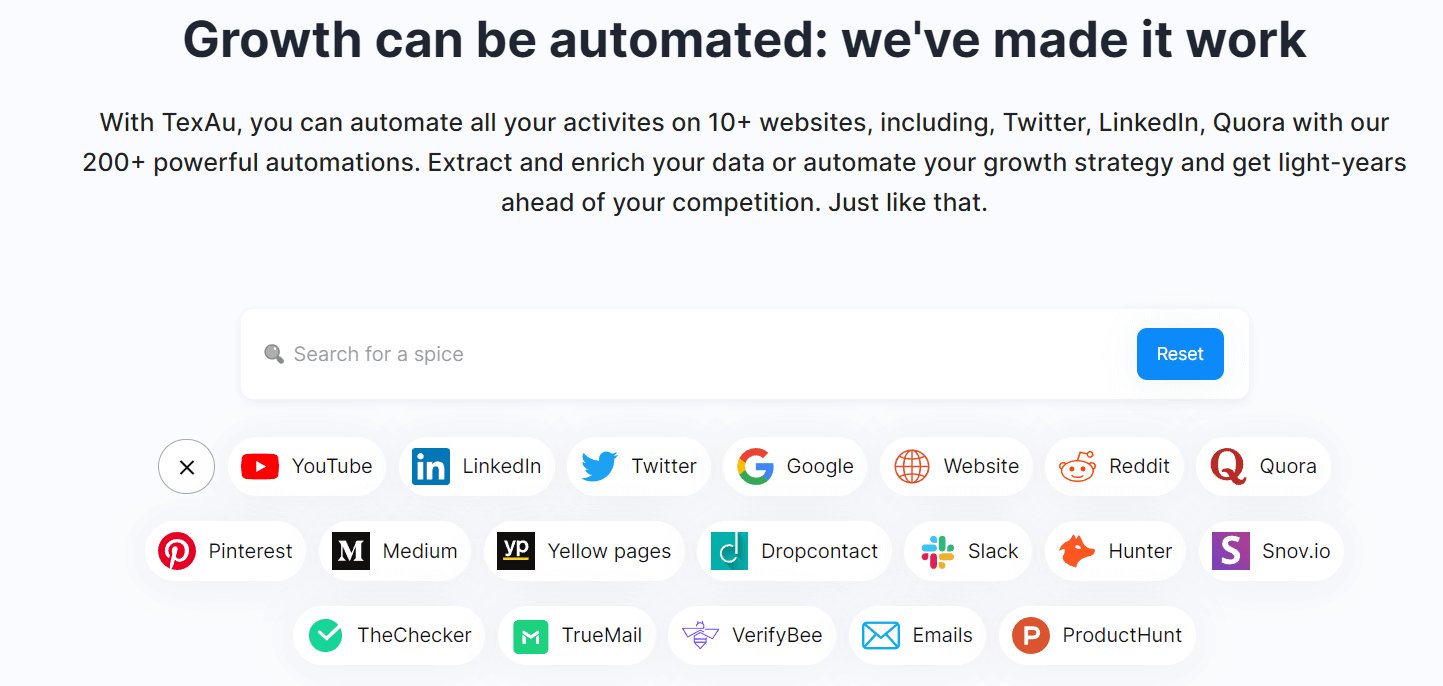
TexAu is a code-free marketing automation and data extraction tool for LinkedIn (and other channels). Though, in this case, we’ll be using it mainly for LinkedIn user scraping.
Since you’ll be targeting high-value companies and multiple prospects from within them, you can use TexAu to:
- Scrape people who follow you on LinkedIn.
- Extract automatically every single piece of data displayed on a lead’s profile (email included), export the sheet, and enrich your CRM.
- Find emails of company employees or extract the full list of employees.
- Scape Sales Navigator searches.
- And more.
This will be one of the most important steps of the puzzle sd you can use Sales Navigator to find your leads, TexAu to scrape their data and information, and Expandi to execute your ABM campaigns
Expandi for account-based marketing
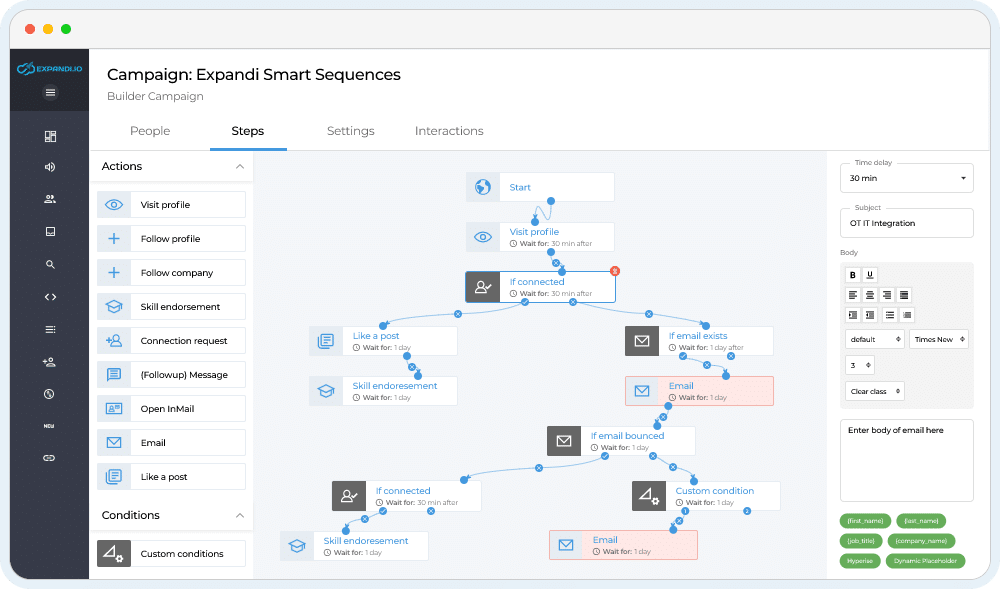
Expandi is the tool that makes your ABM campaign a reality and saves you a lot of time by automating the small parts.
Without Expandi, you’d be sending connection requests, nurturing sequence messages, follow-ups, and more manually. If you want to target just a few people, this is fine.
However, if you want to scale your outreach and target multiple company departments at the same time automatically, you’ll need Expandi.
With it, a potential ABM sequence might look like the following:
- Send a LinkedIn connection request.
- If they accept it, send a cold message.
- If they haven’t replied, follow up in 6 days.
- If they haven’t accepted your request after 4 days, follow up via email.
- If they haven’t replied to your cold message or email, send a LinkedIn InMail.
- If they still haven’t replied, like their latest post or endorse their skill to get on their radar.
Expandi offers 9 different actions and 10 different conditions, so there are a lot of options for what your marketing funnel automation might look like. All of which you can set up with simple drag-and-drop options.
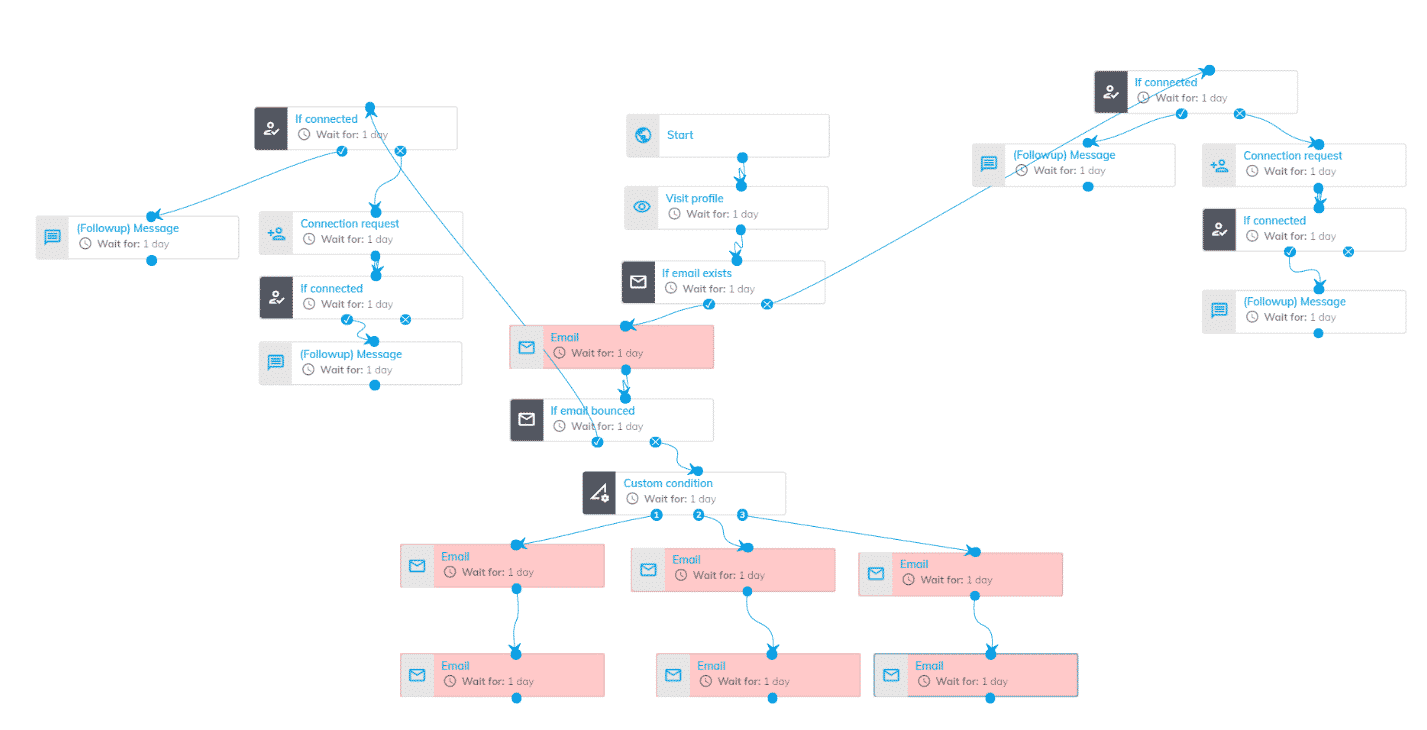
Complicated?
It doesn’t have to be when you can use our proven outreach sequences directly!
See 13 agency growth secrets to learn why LinkedIn outreach agencies choose Expandi for more info.
Zapier to automate your operations and processes

If you’re not already using Zapier to automate your processes, you’re missing out.
This is not strictly an ABM tool, as you can also use it to automate different tasks, but when doing ABM at scale, Zapier is also useful to have.
In an ABM campaign, potential customers need to see the same marketing message multiple times across different channels before they bite.
This means, you’re likely managing a stack of different tools source those leads, scrape data, and reach out automatically.
With Zapier, you can organize leads from different places in one centralized location with just a few Zaps.
The best part is that you can use Zapier for just about any app you use.
Some automation examples you can use include:
- Monitoring your sales funnel in real-time.
- Notifying your team in Slack whenever someone buys something or requests a free trial.
- Share daily or weekly reports automatically in Slack.
- Building your own custom CRM and sales processes.
- Adding new webinar attendees to your email marketing software.
- And more.
HubSpot CRM to enter customer info
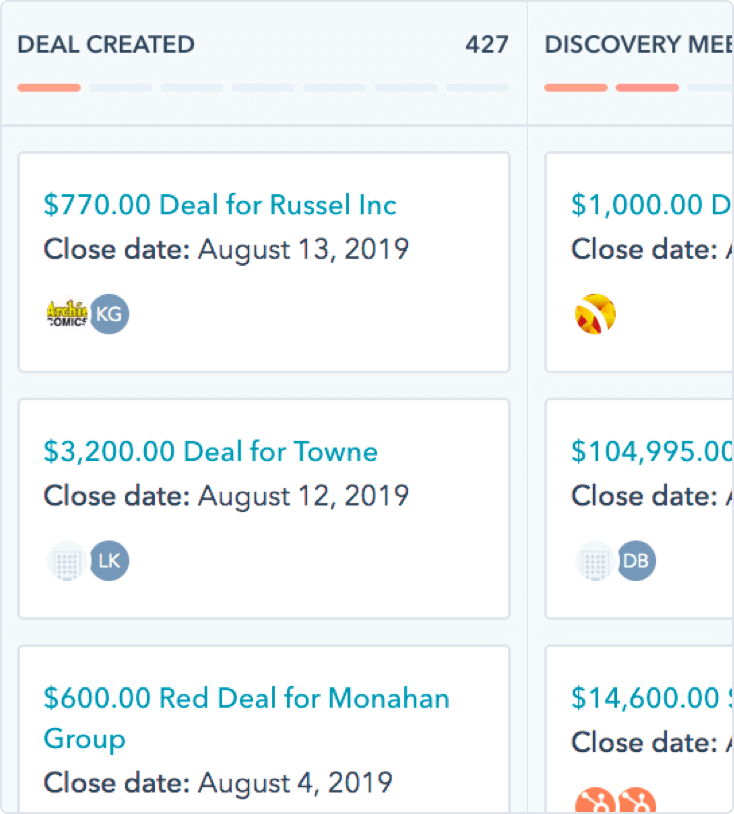
You don’t necessarily have to use HubSpot as your main CRM. Though what’s important is that if you’re doing ABM outreach at scale, you DO use a relevant CRM.
You can also use Salesforce, Pipedrive, Zoho CRM, or something else.
What’s important is that your CRM should be able to:
- Automate workflow and certain processes.
- Integrate with LinkedIn and other APIs.
- Create customer profiles, segment by industry, identify high-ticket customers, and more.
Though this isn’t a definitive list by far.
Some other account-based marketing tools you can use to fuel your outreach include:
- Salesloft to prioritize leads and opportunities.
- PandaDoc to generate quotes.
- ChatGPT to engineer potential cold email and LinkedIn messages (only if done right, check out our guide on the topic).
- Apollo.io to find your ideal buyer (depending on how niche your industry is).
- And more.
Also keep in mind some of the above tools have similar features. You can always find alternatives and adjust your tech stack as needed.
As far as launching ABM campaigns go, we’ll be focusing on using Sales Navigator and Expandi below because they cover finding and reaching your leads, practically speaking.
Detailed Guide On Using LinkedIn Sales Navigator And Expandi For Account-Based Marketing
As mentioned above, there are certain Sales Navigator filters that make ABM much more effective.
To get the most out of Sales Navigator for your next ABM campaign, you’ll need to:
- Set up or gain access to the free trial of Sales Navigator.
- Internalize the 40+ advanced search filters.
- Create and manage lead lists for easier organization.
- Track and engage leads regularly.
Setting up and understanding Sales Navigator
- First, you’ll want to upgrade to LinkedIn Sales Navigator if you haven’t done so yet. Or you can grab the free trial for one month.
- Then, you’ll want to familiarize yourself with the interface and understand the different sections, search bar, filters, lead lists, and so on.
It might seem overwhelming at first, because of how many people and company search filters there are, but you don’t have to use all of them.
Using advanced Sales Navigator search filters for ABM
With Sales Navigator, you can leverage 40+ advanced search filters and Recommended Leads to identify the right people at your target companies. Making it an ideal choice for ABM.
The advanced filters include the following:
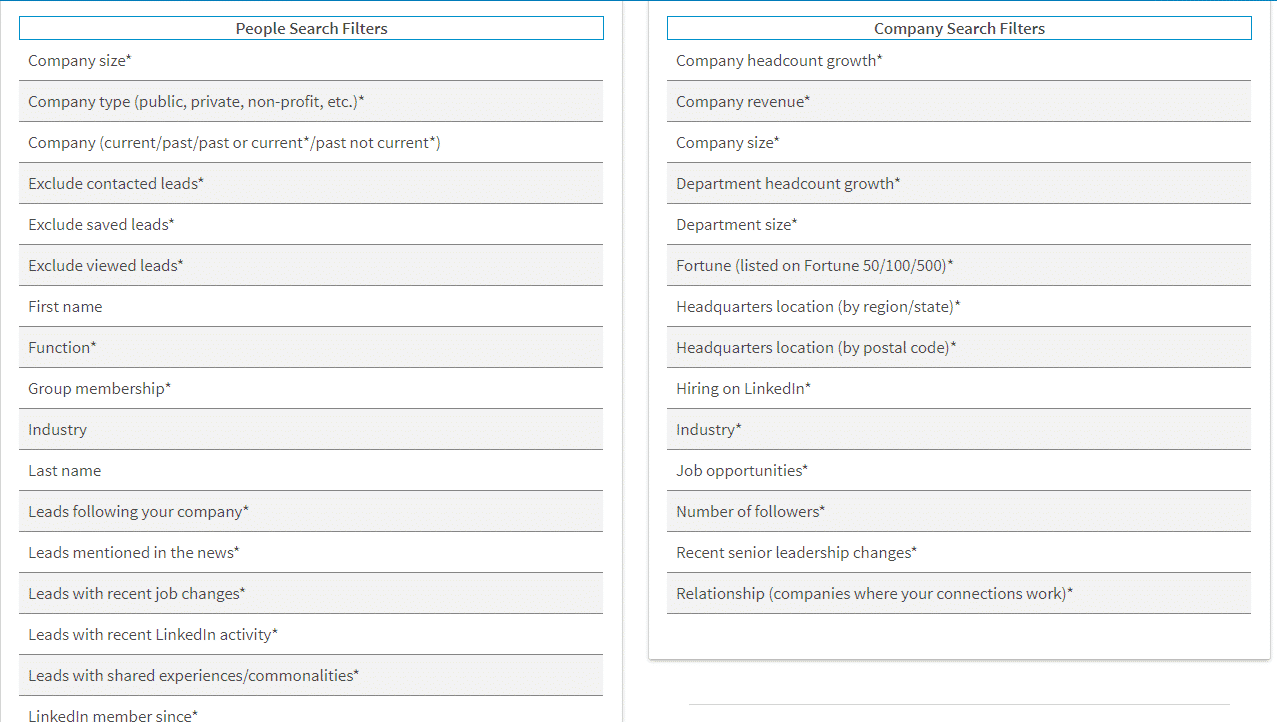
If you’re not sure where to start with so many filters, consider starting backward.
Look at the above Sales Navigator filters and ask yourself how many of those you know about your Ideal Customer Persona.
The more – the better.
Start with job titles, seniority level, industry, and company size to refine your search results.
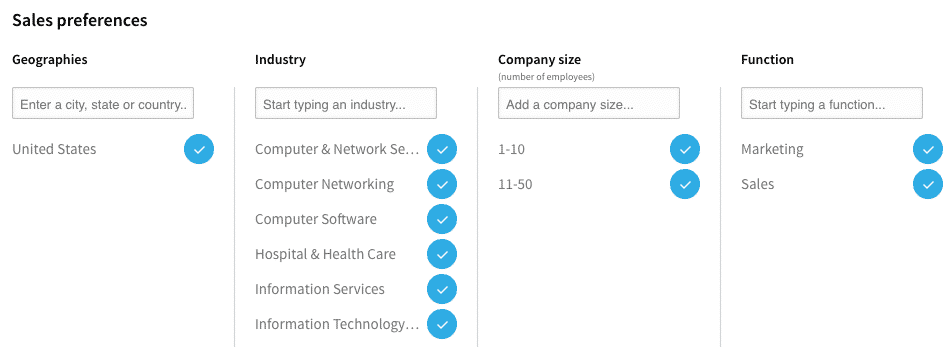
Going beyond filters to find your target audience, the real beauty of Sales Navigator lies in understanding the psychology of your lead’s journey.
Job change filter
For example, with the job change filter, you can target new hires who are just getting started in the company.
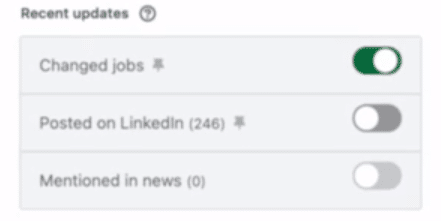
One approach is to use this in your personalization (e.g. “hey (first_name), congrats on the new job start as a (company_role)!”.
However, one way to take this to the next level is to assume their interests and motivations and use them in your outreach.
For example, if your prospect just became a VP of sales, chances are, this person has plans to change the company processes AND the authority to do so.
This also means that the company:
- Is investing into their sales processes.
- May be hiring new SDRs.
- Might be open to hear your pitch about sales software, improving their processes, or helping them in some other way.
All by finding someone who just got hired as a new VP or Head Of Sales in a company!
LinkedIn groups filter
You can take a similar approach with the LinkedIn groups filter.
If someone is in a group called Lead Generation Professionals, that means they are either:
- Interested in this topic.
- Work directly in the field.
- Hire, manage, or outsource their lead generation.
- Actively using lead generation software.
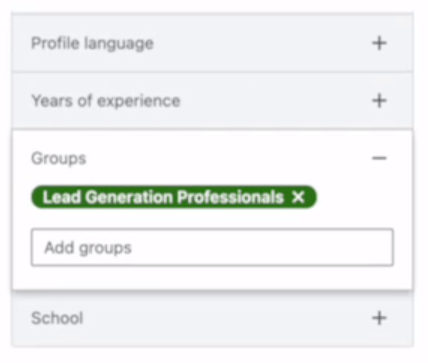
You can then:
- Scarpe the LinkedIn group.
- Enrich lead data and determine who is relevant for outreach.
- Look into their company and what they do.
- And craft a relevant proposal accordingly.
Using technology filter
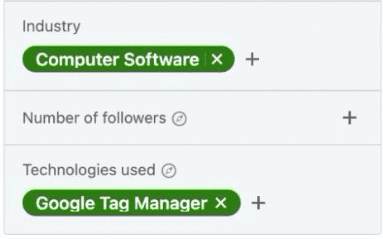
Another underrated Sales Navigator filter is the “technologies using” filter, through which you can filter for companies using certain software.
For example, you can use this to:
- Target companies using specific software that works well with yours to benefit them.
- Reach out to companies using your competitor’s software in an attempt to get them to try yours instead.
- And more.
Remember, Sales Navigator isn’t just about finding something about a company and using that as part of your personalization.
Rather, really think about what it means when a company is using a certain piece of software or if their department headcount is under 35 (new salespeople? Enough budget?).
What are their business challenges? How will this affect the company’s strategy? What do you think they’ll be focusing on moving forward?
Make sure you consider all this information when launching your ABM campaigns.
Creating and managing lead lists
At this point, you should have many different ways to target your audience on Sales Navigator as part of your ABM outreach.
From here, you can use Sales Navigator to view, create, edit, sort, delete, share, and export lead lists for easy access and organization.

From there, you can segment your lead lists based on different criteria. Such as their industry, job title, geographic location, and more.
This allows you to personalize your outreach and messaging depending on who you’re reaching out to.
Combined with the above filters, you should have a solid idea:
- How to find leads.
- What kind of an opening or pitch you should use based on the filters.
- That you can save different Sales Navigator search results, scrape leads, and run different ABM campaigns accordingly.
Tracking and engaging leads
Last but not least, another advantage of using Sales Navigator for ABM is that it also lets you:
- Monitor lead activity: Gain insights into lead activity, such as profile updates, job changes, if they recently posted about something specific, and more. Stay updated on these activities to identify engagement opportunities and tailor your ABM campaigns accordingly.
- Engage with personalized messages: Craft personalized messages based on the prospect’s specific profile and interests. From there, you can highlight relevant pain points, offer solutions, and show your expertise to capture their attention.
- Use InMail and regular email: Last but not least, you can also leverage InMails and cold emails to follow up with prospects and ensure your messages reach their inbox. You can either send a reminder about your LinkedIn message or restate the pitch to make it easier for them,
Detailed Guide On Using Expandi For Account-Based-Marketing
Expandi (that’s us!) is a LinkedIn automation tool to streamline your ABM campaigns and automate your LinkedIn interactions.
It’s the safest LinkedIn automation tool on the market that runs and gets you leads 24/7 by automating otherwise manual tasks.
You can launch your first LinkedIn outreach campaign in 15 minutes and start seeing results in 24 hours.
To get the most out of Expandi in your ABM campaigns, you’ll need to:
- Grab the free trial, set up, and understand how Expandi works.
- Set up outreach campaigns for ABM.
- Track and engage LinkedIn leads with Expandi.
- Get an overview of what’s possible for your ABM campaigns using Expandi.
Let’s take a look at how this works.
And so that you get the most value out of this section, we’ll be creating a potential, real ABM campaign you can run using Expandi below.
Setting up and understanding the Expandi interface
Using Expandi is simple.
But it works best once you already have a defined target audience and ICP.
If you already have saved lead search (see the section on Sales Navigator), you can directly export that search into Expandi.
From there, you create an automated outreach campaign that sends all the connection requests for you.
This way, you don’t have to write the same connection request each time. And instead, you can use different personalization tags (e.g. first name, company name, job title, etc.) which you use in a repeating template.
To get started with Expandi, you can:
- Sign up with a free, 7-day trial here.
- Or book a free, no strings attached demo to get you up and running with Expandi in no time.
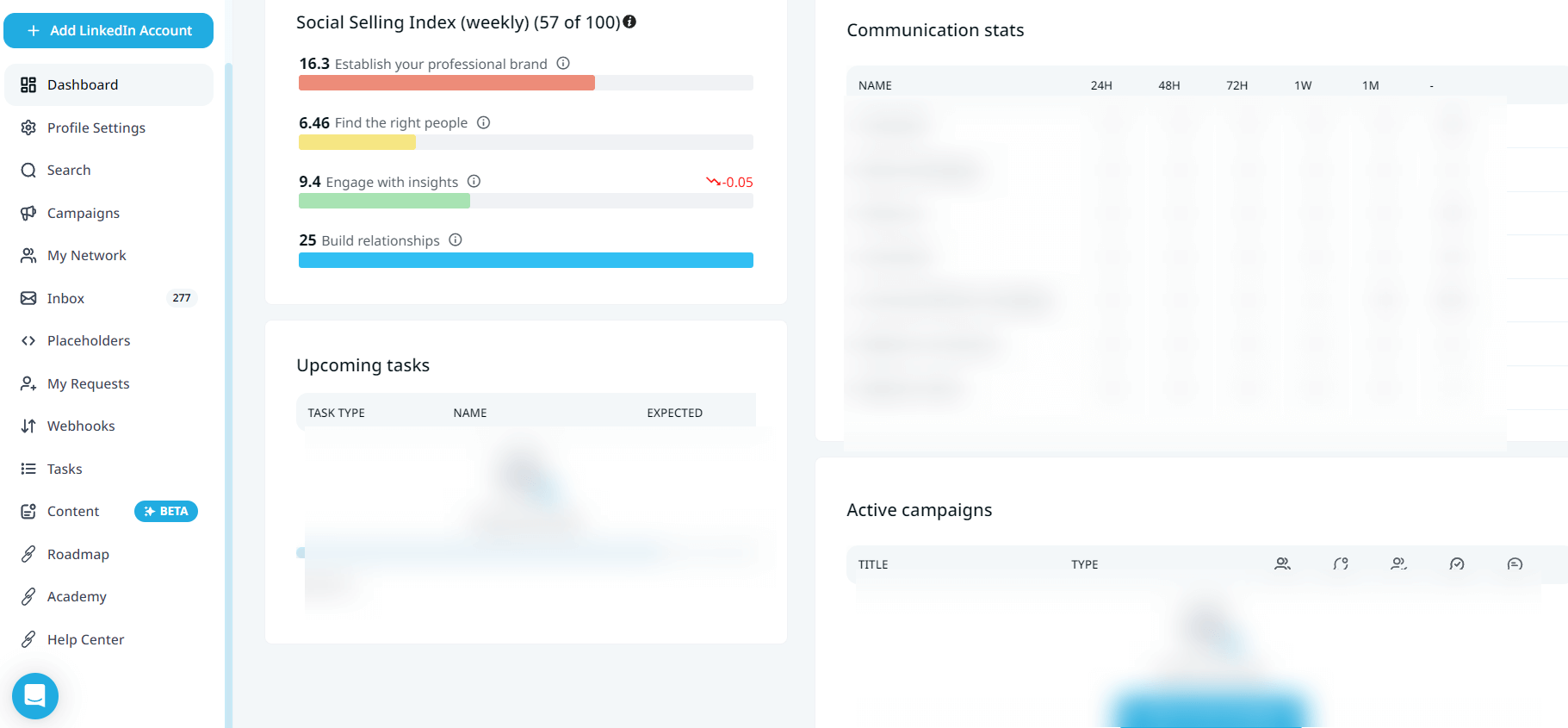
Once you log in and connect your profile, you gain access to different campaign types and search types (see below).
And if you want to become an expert Expandi power user, consider checking out our free Expandi Academy course.

In the 1h30m course, you’ll learn:
- The fundamentals of what Expandi is and how it works.
- Where to find key features and how to use them.
- All the possible ways you can add leads into Expandi.
- Different ways and types of campaigns you wish to build.
- Everything you need to know on connecting the dots together.
- All the hidden and secret features.
- How to manage your agency like a champ.
- And more.
Another important thing to keep in mind is that Expandi offers 11 Actions and 10 Conditions which you can use to customize your ABM campaigns.
These are as follows.
Actions:
- Visit profile.
- Follow profile.
- Follow company page.
- Endorse skill.
- Send a connection request.
- Send a connection request based on leads in spreadsheet file.
- Send a mobile connection request (to avoid LinkedIn limits).
- Send a follow up message.
- Send an open InMail.
- Send an email.
- Like their post.
Conditions:
- If connected.
- If followed you.
- If visited your LinkedIn profile.
- If opened your email.
- If your email bounced.
- If clicked your email.
- If their email exists.
- If they have an open profile for InMails.
- If they liked a post.
- Custom condition.
Now, let’s take a look at the different kinds of outreach campaigns you can create with Expandi before we cover an ABM example.
10 different outreach campaigns types to use for ABM with Expandi
In Expandi, you can create 10 different outreach campaigns when doing LinkedIn cold outreach.
The campaign types are as follows:
- Mobile Simulation Campaign – On average, most people on LinkedIn can send about 80-100 connection requests per week, because of the LinkedIn algorithm. However, by using this campaign, you can bypass this limit by using LinkedIn via mobile. This campaign emulates sending connections from your mobile.
- Campaign builder – This campaign enables you to warm up your outreach by including actions such as visiting a profile, following someone, endorsing them, liking their post, and more. Making it ideal for lead generation, networking, connecting with new people, and more. This is typically what you’ll be using for most ABM campaigns.
- Open InMail campaign – With this campaign, you can send open InMails (free if someone has an open profile) and cut through the noise when doing outreach.
- Company Follow Invite Campaign – it lets you ask your 1st-degree connections to follow any company page on LinkedIn, even if you don’t have admin rights.
- LinkedIn group campaigns – If you’re in the same group as your ideal customer persona, you can message them directly without being connected. This is ideal if you know what groups your target audience is in.
- LinkedIn event invite outreach – With this campaign, you can invite up to 1,000 people from your network to a webinar automatically. Making it ideal if you’re hosting an event custom-tailored to your ICPs, since you can invite multiple people within your ABM campaign.
- Connector campaign – Essentially, this campaign allows you to reach out and automatically send connection requests to your leads. This is the most popular type of Expandi campaign because of how much customizability it offers, especially for ABM. You can use it for Sales Navigator searches, basic LinkedIn search results, imported CSV spreadsheets, group searches, and more.
- Messenger campaign – The Messenger Campaign is to automatically reach out to members of your first-degree connections on LinkedIn.
- Inbound campaign – As more and more people visit your LinkedIn profile, you can use the Inbound Campaign to capitalize on this and reach out to people who have viewed your profile directly. This is ideal if you’re also posting a lot of content and want to build a custom flow based on how you’d like to reach the leads in an ABM campaign.
- Recovery campaign – Last but not least, the Recovery Campaign is if you accidentally deleted a campaign and need to cover some data from it. All you have to do is set a date and time range, and the campaign will show everyone you reached out to and the last message they received. If you’re managing a lot of ABM outreach campaigns, this might come in handy to recover data.
This might seem overwhelming, but remember, most of your ABM flows will include:
- Connecting with someone to start building your relationship
- Sending a relevant pitch, value proposal, or asking questions to gauge their interest.
- Following up via LinkedIn, InMail, or email.
From there, you can add different actions and steps as needed.
Read on to see potential sequences for an ABM campaign below.
For more info on that and how each campaign type works in detail, see our full guide on LinkedIn cold outreach.
Tracking and engaging with leads in Expandi
Naturally, when doing outreach of any kind, tracking campaign performance is one of the most important steps you can take.
Within Expandi, you gain access to campaign insights, leads, and other important ABM information all in one place.
This way, you can reply to leads, perform A/B tests, and optimize campaigns accordingly.
Generally speaking, you can break down your lead status into 5 distinct stages:
- Awareness – When leads first learn about your offering.
- Interest – When leads look into your profile, company, and offer.
- Evaluation – Leads make an initial evaluation of your pitch. Often, they consider if it’s relevant to what they’re looking for and if the prices align with their expectations.
- Engagement – When leads engage with your salespeople and learn about your use cases, features, pros, and more.
- Purchase – Finally, when leads decide to pull the trigger and purchase your offering.
Fortunately, tracking your leads is very simple in Expandi as you track leads via campaign, status, custom tags, and more.
For example, within your ABM campaigns, you can filter for people with a specific status, such as:
- Contact – 1st-degree connection.
- Searched – Not connected yet.
- New contact – Accepted your request not too long ago.
- Connect request – Request sent to the lead but not accepted yet.
- Imported – Lead was imported to your campaign via CSV spreadsheet file.
- Disconnected – No longer 1st-degree connections.
- Revoked – Connection request was rejected or withdrawn.
Or a reaction type such as:
- Like.
- Praise.
- Empathy.
- Interest.
From there, you can create different nurturing sequences for different leads based on their status.
Try to look for triggers unique to the individual as that will be what makes or breaks your ABM campaign at the end of the day.
Now, with all this in mind, let’s build out a potential ABM campaign with a live example below, using Expandi.
Setting up your first ABM campaign with Expandi from scratch (step-by-step with a real examples to copy)
Big part of the success of your ABM campaign comes down to targeting the right people within the right organizations with the right message.
So, at this point, you should hopefully have your goals and ICP defined. Because, we’ll be looking at practical campaign steps within Expandi here.
For this example campaign, we’ll be targeting leads from a LinkedIn group using a Campaign Builder. Though, the same process works whether you’re using a Sales Navigator search, targeting 1st-degree connections, or anything else.
For this to work, you need to be in a LinkedIn group you’re targeting for at least 4 days.
Let’s assume we’re targeting LinkedIn marketers and growth hackers. In that case, this group will work fine.
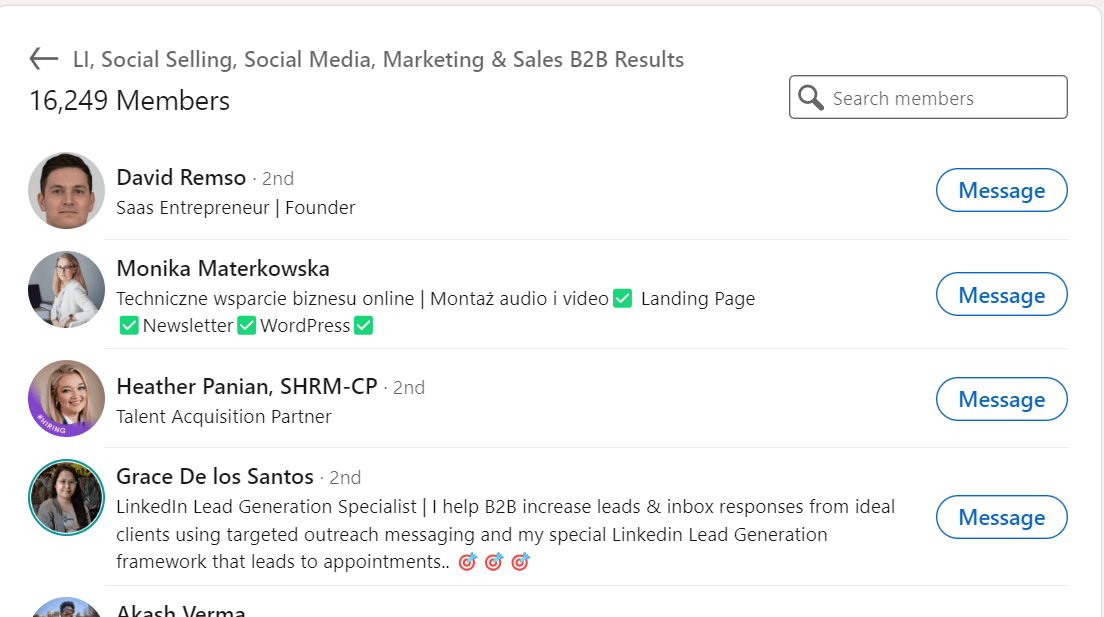
So, first, you’ll want to export a group of leads into Expandi.
To do that:
- Click Search in Expandi.
- Then, click on Add new search.
- From there, you can select a different Search type based on who you want to reach out to. Or you can even upload your own list of leads. Since we’re targeting people in a LinkedIn group in this example, I select Group Search.
- Enter a search name.
- Paste the group URL from LinkedIn. By default, Expandi can scrape only 2,500 contacts here. But if you want to scrape more, turn on Auto reload.
Then, wait a few minutes as Expandi scrapes the leads from the group.
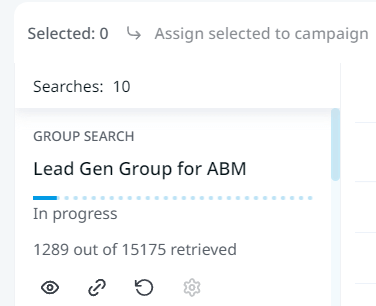
Now, once Expandi has scraped the group, you can transfer it to your Campaign Builder. In which we’ll set up the ABM outreach sequence steps.
Before we do that though, it’s recommended you filter down your list of leads so that your campaign is more targeted.
You can do so within Expandi using the filters.
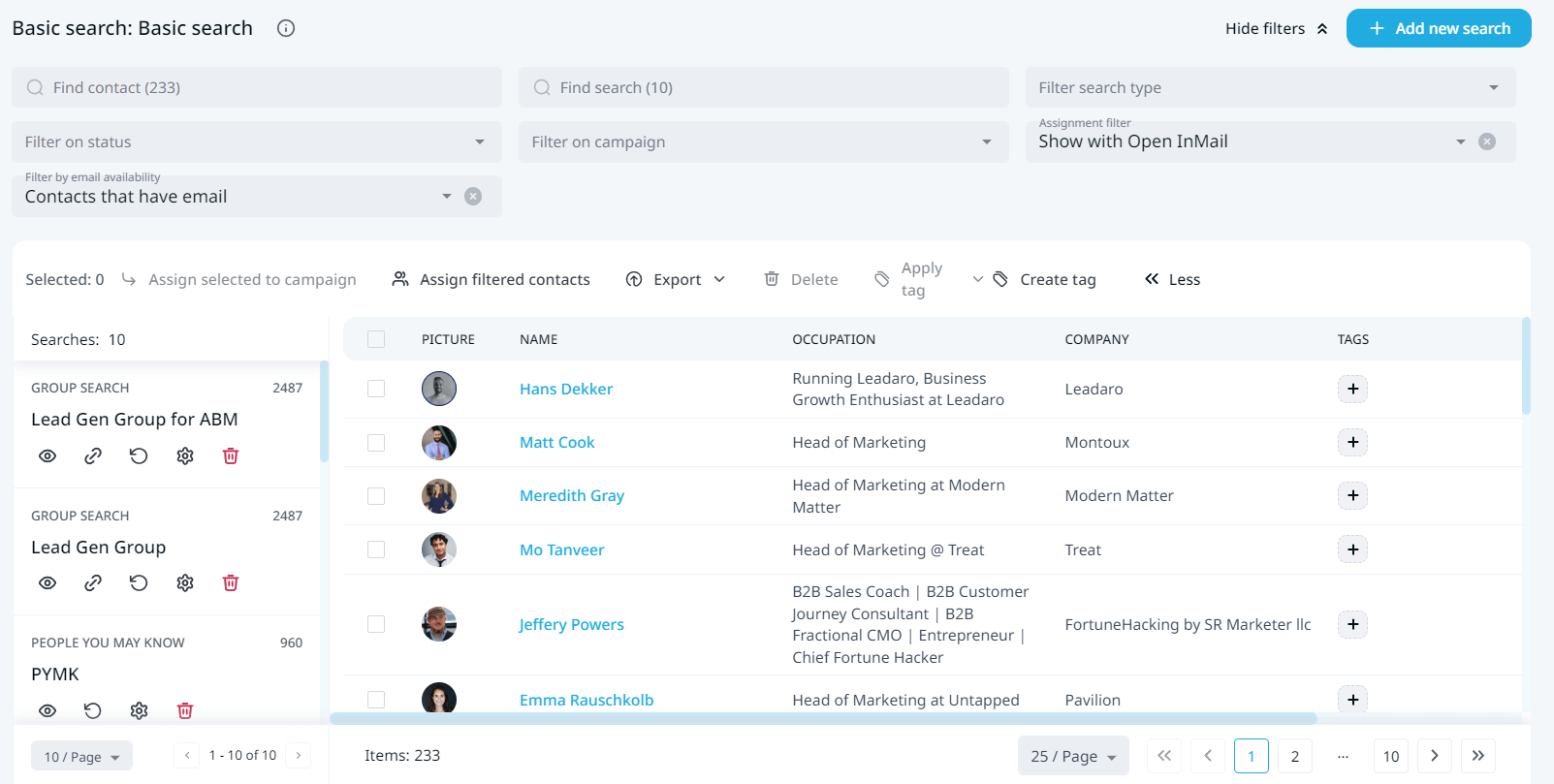
Or you can download the list as a spreadsheet CSV file by clicking Export and Mail filtered contacts as CSV.
Note that Expandi can’t always find the leads contact info. So, you can further enrich the list of leads. For more info, see how to build a prospect list.
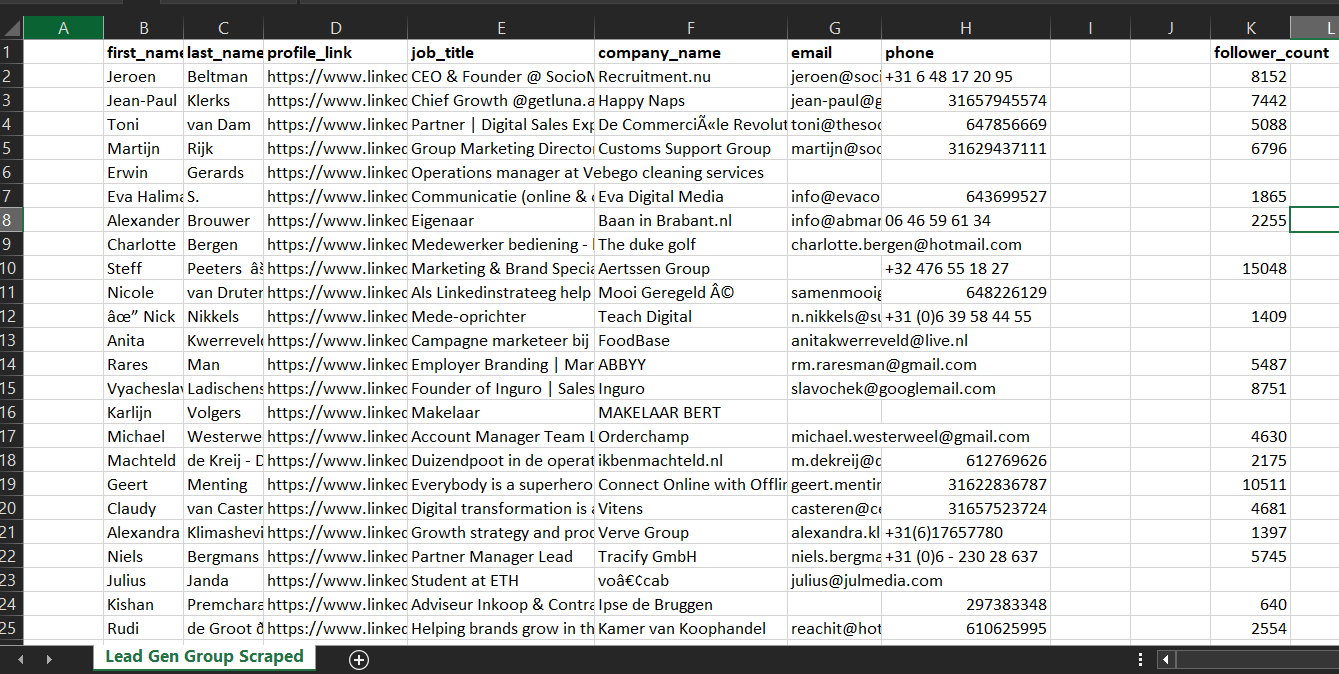
Additionally, you can get a VA to further narrow down your list of leads based on:
- Their position.
- If their company fits your ICP.
- How many people work at that company.
- If they work within a specific segment (e.g. LinkedIn outreach).
- How many people follow them.
- And more, based on who your target audience is.
For example, you can get a VA to narrow down your list of leads to target only CEOs from the group. In other words, CEOs working closely with LinkedIn and outreach in this case.
Now, once you have your list of leads ready, you’ll need to prepare an ABM outreach campaign within Expandi to contact them.
Here’s how to do that:
- Go back to the Campaigns section in Expandi.
- Press Add Campaign and select Campaign Builder.
- Select a campaign name, click Next, and Create without template.
Now, we have to add our Steps (outreach sequence) and a template.
To save you time, a potential ABM campaign might have the following steps:
- Send a connection request, if not yet connected with a prospect. In this case, we’re targeting people we’re not connected with. Alternatively, you can set up a different condition to start sending messages directly IF you are connected.
- If they accept the request – send a cold message Optional, but consider using dynamic personalization here to capture their attention.
- If they still haven’t responded, like their latest post as a ‘gentle’ reminder.
- Send a follow-up message.
- If they still haven’t responded, endorse their skills as a ‘gentle’ reminder.
- Send a final LinkedIn follow-up message.
- If they do NOT accept your request, like their post.
- If they still do NOT accept your request, send an email follow-up. Note: You have to set up SMTP integration settings from your profile in Expandi to send emails with your campaign.
- If there is still NO reply, follow their profile on LinkedIn.
- If there is still NO reply, send a LinkedIn InMail as a last resort.
If there is still NO reply after all this, consider setting up a different campaign in which you check in with your leads after 1-3 months to possibly re-engage with them later.
Now, let’s set up these steps in Expandi and then we’ll write up the templates.
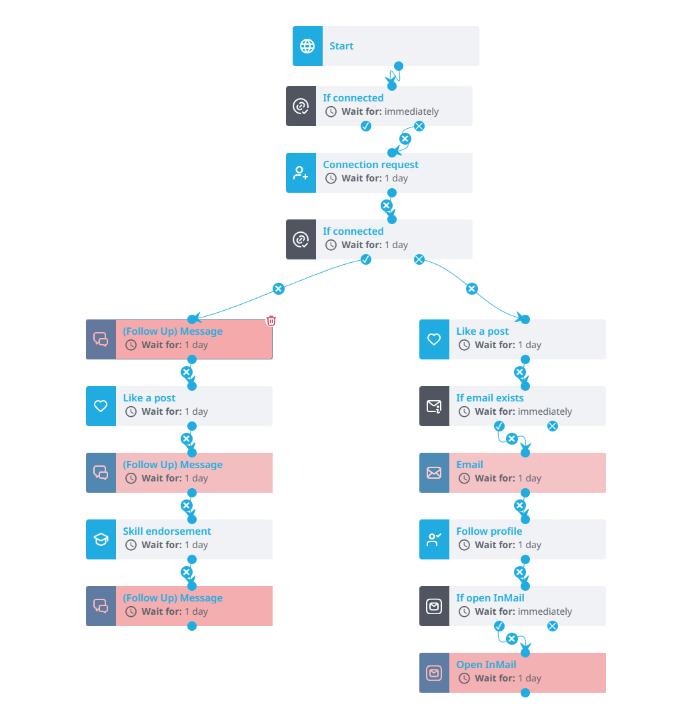
Now, as you can see, some of those actions are red. That’s because they still need the body text.
So, let’s do that now.
Note that your outreach template will depend on your audience, goal, and objectives.
So, this is just one potential example.
Connection request template
The beauty of this template is that you can record the Loom video after they connect with you.
In other words, you don’t have to create hundreds of personalized Loom videos for each lead in advance.
“Hey {first_name},
Came across your profile from the LinkedIn social selling group.
I help CEOs supercharge outreach to the point they consistently get up to 72% reply rate.
Would it make sense to send over a personalized 3-minute Loom for what this could look like for {company_name}?”
If connected follow-up message
“Glad to connect, {first_name}.
Here’s the Loom video: [URL]
If this is something you’re focusing on at the moment at {company_name}, I have a few more ideas you could implement in your outreach today.
How does a call next week, any time Monday to Wednesday sound?”
If no reply, follow-up message after 4 days
“Hey {first_name},
Got a notification you saw the video so I wanted to follow up on this.
We recently helped Salescout (agency similar to yours) book 6 new demons and $250k in their pipeline in just 3 weeks using an omnichannel outreach campaign.
Can’t promise similar results. But if you’re open to it, we can discuss a potential strategy on a no-strings-attached 10-minute call for {company_name}.”
If no reply, follow-up message after 9 days
“Hey {first_name},
Just wanted to follow up one last time to check if this is relevant for you right now.
I only have the capacity to take on 1 more client within the next 3 months.
Let me know if you’re in?”
If connection request not accepted email message
Subject line: Is this relevant for {company_name}?
Hey {first_name},
Saw we’re both in the LinkedIn social selling group.
I help CEOs supercharge their outreach to the point they consistently get up to 72% reply rate through omnichannel outreach campaigns.
We recently helped Salescout (agency similar to yours) book 6 new demons and $250k in their pipeline in just 3 weeks using an omnichannel outreach campaign.
So, thought this might be relevant for you too.
Would it make sense to send over a personalized 3-minute Loom for what this could look like for {company_name}?”
LinkedIn open InMail if no email reply
Subject line: Better outreach for {company_name}?
Hey {first_name}.
Would getting up to 72% reply rates for {company_name} outreach campaigns be something relevant at this point in time?
We managed to help Salescout (agency similar to yours) book 6 new demos and add $250k in their pipeline in just 3 weeks, using our novel omnichannel outreach campaign flows.
Can’t guarantee I’ll do the same for you.
But I’ve got a few ideas that you can implement today that’ll at least skyrocket your connection request and reply rates.
Interested?
Feel free to book a 10-minute, no-strings-attached call here: [Calendar URL].”
3 Best Practices To Keep In Mind When Launching ABM Campaigns On LinkedIn
Finally, before we recap, let’s go over some of the most important best practices to keep in mind when launching ABM campaigns.
When running ABM campaigns on LinkedIn, it’s crucial you’re also:
- Creating compelling content for your ICP that gets you leads or profile visits.
- Engaging with your leads one-on-one.
- Constantly monitoring and tweaking your strategy based on data and campaign performance.
Here’s what this means in pratice.
1. Creating compelling content for your ICP
ABM leverages both inbound and outbound.
So, for maximum effectiveness, you should also be creating high-quality content that either gets leads to reach out to you directly or at least visit your profile to learn more.
One way to approach your content strategy on LinkedIn is with the 40/40/20 framework, which means:
- 40% expertise posts – Posts that provide value, educate the reader, and establish yourself as an expert in your niche.
- 40% engagement posts – Posts that boost your engagement and reach. While these kinds of posts may not get you leads, they’ll get you more followers and connections.
- 20% promotion posts – Finally, you should also be creating relevant content based on your ultimate solution (service, product, software) and what problem you solve. This could be a case study, video content, a use case of your solution, social proof, and more. This might get less engagement, but the goal is to generate leads.
When creating LinkedIn content, focus on building relationships and getting leads.
Posts like this, for example, help you move public conversations into a one-on-one, more personal relationship. In which you can help your audience, generate meetings, and develop your relationship.
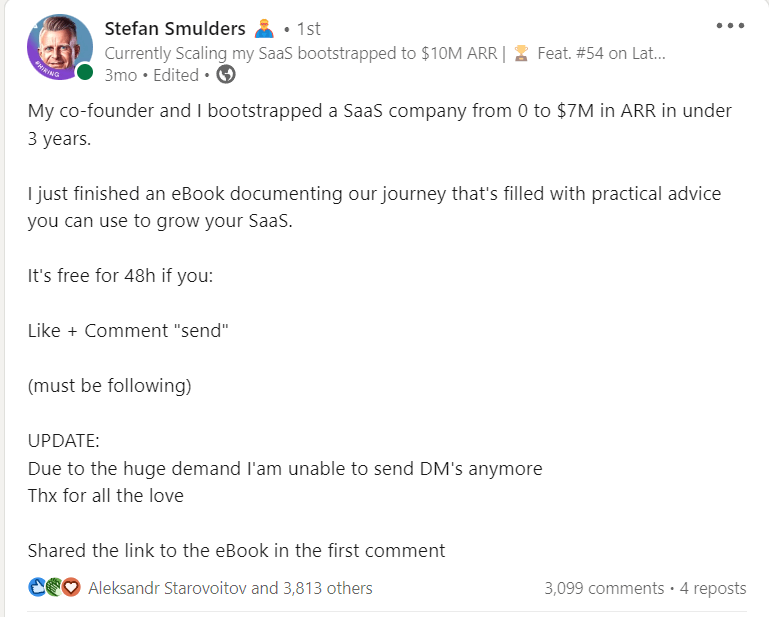
When creating for your audience, be sure to also:
- Understand your audience, down to their insights and pain points.
- Tailor content to their buyer’s journey. How do you get them from being unaware of what you do to making a purchase?
- Leverage various content formats, across articles, carousels, video content, and more.
- Showcase thought leadership. Establish your brand as a thought leader by sharing insightful and relevant content – based on your unique experiences, trends, and opinions.
2. Engaging with leads
Engaging with your leads is an important part of ABM to build relationships and foster meaningful connections with your ICP.
This is also a great way to nudge your leads and get on their radar.
For example, sending another follow-up message the day after sending your message might be too quick.
However, you can automatically engage with leads via Expandi by endorsing their skills, liking their latest post, follow their company page, and more.
Here’s an example.
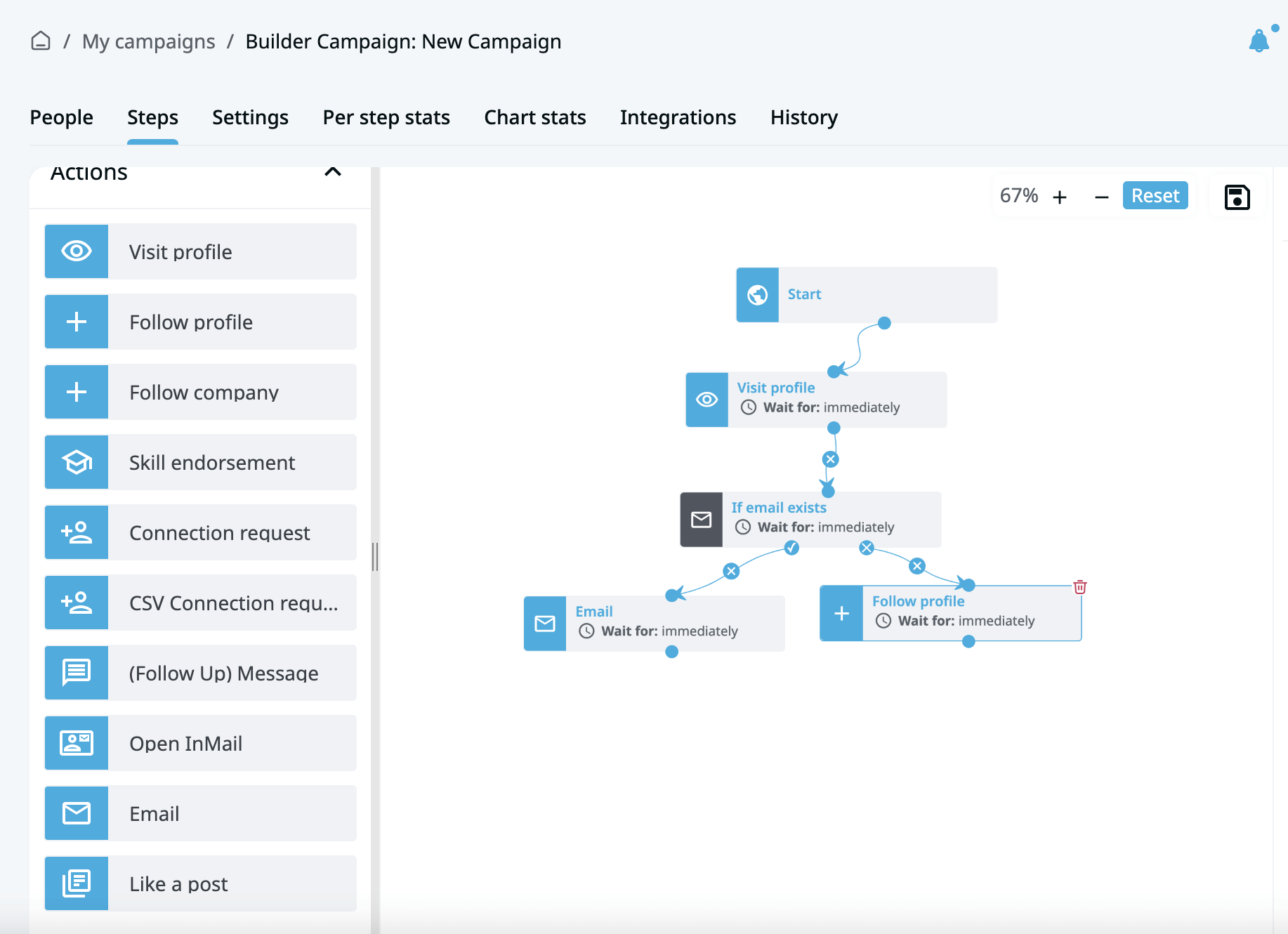
You can also add possible outcomes with custom condition step, which includes:
- If connected.
- If followed.
- If visited your profile.
- If opened your email.
- If clicked your email.
- If your email bounced.
- If their email exists.
- If opened your InMail.
This way, you can engage with leads automatically and automate the boring stuff you would do to get on their radar.
3. Monitoring and tweaking your strategy
Last but not least, with every ABM or outreach campaign you launch, you should always be monitoring and tweaking your strategy based on campaign results.
When measuring your lead generation efforts, you analyze different KPIs such as your connection acceptance rates, reply rates, demos booked, and more.
And it’s always important to take a look at the bigger picture of your strategy when doing so.
For example, if you have a connection acceptance rate of 87%, it might seem your campaign is performing well.
But what if you have a low reply rate and you’re not booking any meetings?
This is why it’s important to always look at the strategy.
You make more informed ABM decisions based on the sales engagement data and results.
If you have a low reply rate, then you might want to experiment with your sales pitch angle or call-to-action.
Meanwhile, if you have a low meetings-booked rate, you should consider changing your offer or the audience you’re reaching out to.
When launching ABM campaigns from Expandi, you gain access to all this data and more with a single glance at your dashboards.
Which looks like this:

Alternatively, you can zoom in on your ABM nurturing steps and analyze stats per steps.
Which looks like this.
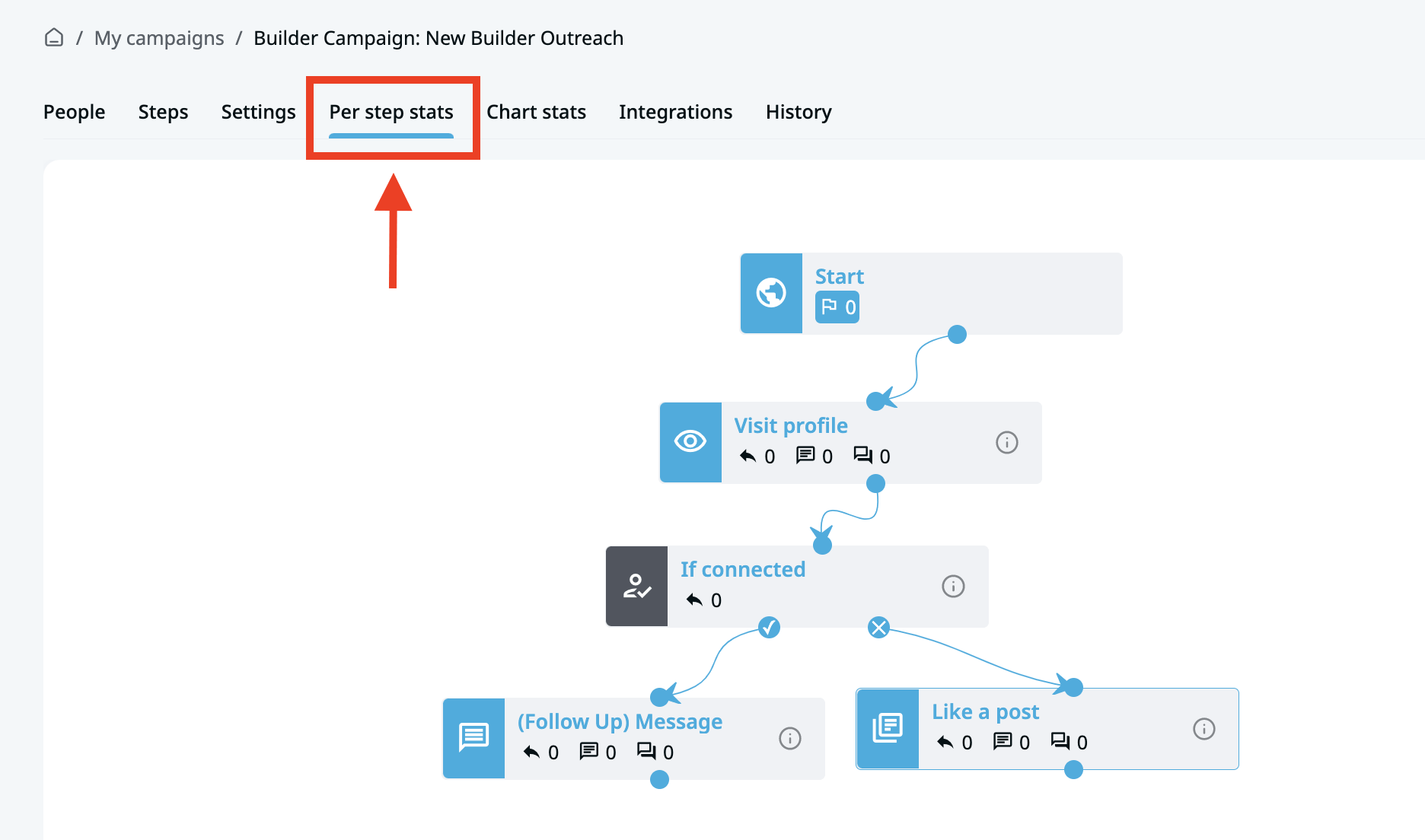
Conclusion
So, to sum up, LinkedIn account-based marketing (ABM) is one of the best ways to get new clients and boost your revenue.
It combines marketing and sales to generate leads on autopilot. And it also focuses on the importance of building relationships and engaging key prospects (sometimes from the same company) to yield better results.
Looking at it from a bigger picture, the process usually looks like this:
- Establish your ABM goals.
- Prepare your team (marketing and sales departments).
- Get the right tools for the job (in this case, Sales Navigator and Expandi).
- Determine your ideal customer persona and how to find them on LinkedIn.
- Pick your specific, target organization and individuals.
- Set up an automated ABM campaign.
- Create targeted content and monitor the success and your ABM campaign performance.
The best thing about this is that you can plan, execute, and manage your first ABM campaign completely for free.
All with generous free trials.
So, to get started, you can:
Only the best strategies will bring the best results
New articles straight to your inbox

